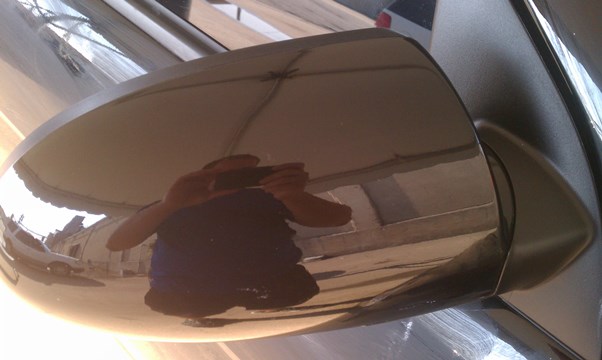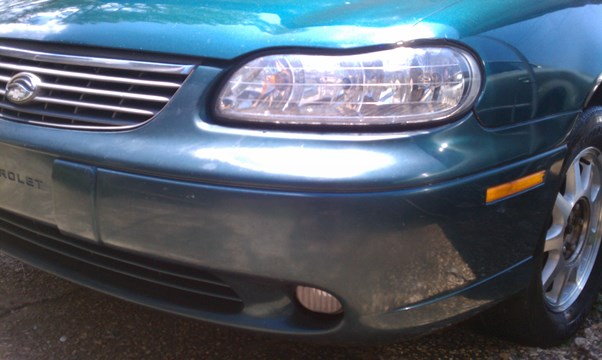Mention overspray to Craig Opel, the western division manager at coatings contractor Brazos Urethane, Inc., and two words come to mind: “Good luck!”
For many applicators, overspray is simply an occupational hazard. The high volume of coatings on major jobs puts anything close at risk, and vehicles are easy targets. Precautions are taken, but perfection remains evasive.
“It’s really a fancy word for engineering controls,” Opel said of avoiding overspray. “We simply have to contain by either spraying inside our spray booths or by moving cars.” According to him, those are “the only two things you can do.”
“You can cover cars, and we do that regularly. But the problem is that it just raises the level of awareness from owners that there’s a problem, and then you always have one or two people just looking for anything that might be on their cars,” Opel continued. “And we’re an easy target to blame. You have to be careful.”
Jobs involving heavily-trafficked areas remain troublesome. While clients are urged by contractors to secure the area, many times it is not possible.
“Public buildings are probably the worst, because you can’t control the public,” Opel said. “Whether it’s a school, courthouse, or anything like that, they’re open during the week. So your choices are you [move or cover] the vehicles, and usually if it’s a school, you’re limited to where you can move cars. So you’re limited with your options.”
Jobs near major roadways often find similar problems, especially on windy days. Even if there is little wind at the surface, conditions can be different when spraying from above.
“I’ve seen a lot of cars get overspray because they were simply driving by,” Opel said. “I’ve seen guys spray on roofs, and the freeway is right below. It just blows over.”
One preventive option is a “dry-fall system,” in which coatings are engineered to air-dry before hitting the ground. But these coatings provide a flatter appearance and less gloss, so they are not always acceptable to clients.
So what’s a contractor to do if overspray can’t be engineered out of the equation?
Pricing Evolves
Many years ago, the belief was that if overspray got on a vehicle, the only fix was completely repainting it. According to Gregg Goodhart, owner of Just Like New Overspray Removal, Inc., that could cost more than $1,000 per car. Fortunately, that is no longer always the case.
Today, overspray may be easier for professionals to remove, and often at fraction of the cost of repainting. In fact, many repaint jobs are completed for $500 or less, Goodhart said, if parts are not affected. That means that while repainting is not necessary in many cases, textured plastic parts in newer vehicles are a challenge.
“There is no way to safely remove overspray from those pieces,” Goodhart said. The materials used to remove overspray don’t work well there, so they use a different strategy. “In those cases, when plastic parts are over-sprayed, we repaint those on site. There’s a new flexible coating paint made for those pieces, and if we have to do that, it affects the price. We have to do it a lot with newer vehicles.” According to Goodhart, though, repaint is still a much cheaper option — often around $1,000, for the full job — than ordering new parts.
“You could be looking at around $2,000 for just the parts,” Goodhart said. “That’s not even factoring in the replacement yet.”
For the vehicle body, one popular product is Clay Magic from car care group AutoMagic. The oval-shaped product works with a lubricant, and specialists rub the clay bar over the affected area several times, using a back-and-forth motion. According to AutoMagic, the product is safe on all vehicles, and it removes harmful surface contaminants such as overspray without affecting the paint. According to AutoMagic, a standard 200-gram (0.7 ounce) bar can last up to 20 details, depending on contamination levels.
In recent years, another option has surfaced involving “nano pads” or rags, based on nanotechnology.

“With these nano pads, there’s a new rubberized surface on one side that actually removes the overspray,” Goodhart explained. “On the opposite side, it’s microfiber just like a towel. It acts the same way as clay, but it’s in the form of a mitt, so there’s a much larger surface area, and the job can get done faster. You can still use the clay as well.”
Working With Overspray Specialists
The best bet might not be for the contracting company to remove the overspray on its own. Positive relationships between contractors and removal specialists are essential.
“Once we get involved, we’ll take over the entire claim so the contractor can get back to whatever they normally do,” Goodhart said. “We’ll take the list and contact each individual, set up the times, and deal with any problems or concerns they have.”
Liability Concerns
Much of the immediate overspray liability often remains with the contractor, even if the client did not provide adequate containment opportunity. Some large contractors may have a liability policy that includes overspray, but in general, overspray coverage can be limited. As a result, having an overspray specialist on standby can be quite helpful.
“Many of the policies are written to where each vehicle owner is a separate claim for the contractor,” Goodhart said. “They may have a $500 deductible per claim. Once they [contractors] have a big claim, they suddenly become very aware!”
With a weak policy or even none at all, the need for trust between contractors and specialists is crucial. “When contractors first started out dealing with overspray, they only cared about how cheap it was,” Goodhart said. “But then they realized that you get what you pay for. You might get it for dirt cheap, but then they have all sorts of problems, and they have to call someone else to fix it. What they thought they saved, it ends up costing three times as much!”
Goodhart used repairing plastic pieces as an example to warn of consequences for contractors that choose unproven overspray removal companies: “We have competitors that don’t have the repair option,” Goodhart said. “They’ll do the removal on paint, glass, and chrome, and write up the rest as un-cleanable. From there, either the contractor pays or insurance gets involved in replacing parts. Either way, costs mount quickly.”
“We’ve had so many companies that we’ve worked with for 10 or more years, and that’s because they know they’re going to get a certain amount of service and quality from us. They want to be able to rely on someone,” Goodhart continued.
In some circumstances, though, it pays for the contractor to do research before even looking into removal as a solution. For instance, when Opel’s team found a car as an unexpected overspray victim during a recent coating job at the Sierra Community College in California, they found that a faculty member had driven around barricades to park beside the building. Based on that, Brazos Urethane eliminated its liability!
Looking Forward
While infrastructure maintenance should provide job opportunities in the future, it also brings heightened risk from overspray hazards — especially if traffic cannot be fully rerouted. So contractors who work with sprayed materials will need a clear plan.
“We face overspray on almost a daily basis, because that’s what we do,” Opel said. “We spray material. It’s going to be a concern for as long as we’re in business.” With partners in the industry, dealing with overspray may be a bit easier to handle.
This feature is part of a special anniversary series in 2017 in which CoatingsPro
is reflecting on and updating the magazine’s most-read digital stories. To see the original article, as it appears online, please click here.
